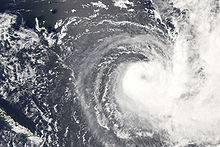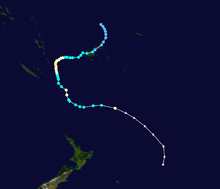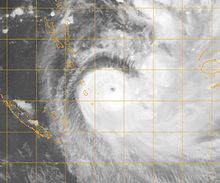- Cyclone Gene
-
Severe Tropical Cyclone Gene Category 3 cyclone (Australian scale) Category 3 cyclone (SSHS) 
Tropical Cyclone Gene near Peak intensity Formed January 25, 2008 Dissipated February 9, 2008 Highest winds 10-minute sustained:
155 km/h (100 mph)
1-minute sustained:
185 km/h (115 mph)Lowest pressure 945 mbar (hPa; 27.91 inHg) Fatalities 5 Direct, 3 Indirect Damage $35 million (2008 USD) Areas affected Fiji, New Caledonia, Vanuatu Part of the 2007-08 South Pacific cyclone season Severe Tropical Cyclone Gene (RSMC Nadi designation:12F JTWC designation:15P) was the deadliest storm as well as the most damaging tropical cyclone of the 2007–08 South Pacific cyclone season east of 160ºE. RSMC Nadi monitored Gene as the 12th tropical disturbance, as well as the fourth tropical cyclone and the third severe tropical cyclone to form west of 160ºE during the 2007–08 South Pacific cyclone season. Gene was also recognised by RSMC Nadi as the fifth tropical cyclone and fourth severe tropical cyclone to form within the South Pacific Ocean during the 2007-08 season.
On January 25, a tropical disturbance formed within the Fijian Archipelago and was designated as Tropical Disturbance 12F. The next day it was upgraded to a tropical depression, whilst on January 27, RSMC Nadi named the depression as Cyclone Gene. Later that day Gene made landfall on Fiji, and caused 8 deaths and $51 million (2008, F$). Cyclone Gene then slowly intensified to a category three cyclone on both the Saffir Simpson Hurricane Scale and the Australian Cyclone Intensity Scale. Gene then took a turn to the south moving towards 25°S which marks the edge of RSMC Nadi's area of responsibility with the Tropical Cyclone Warning Centre (TCWC) in Wellington, New Zealand. Gene then crossed 25°S on February 3 and Nadi released their final advisory. Cyclone Gene continued as a Tropical Cyclone for three days before becoming an extratropical cyclone. Early on February 6 TCWC Wellington released their final advisory on tropical cyclone Gene as they declared it as extratropical.
Contents
Meteorological history
On January 25 an area of low pressure formed within the Fijian archipelago in the southwest Pacific Ocean, later that day the Regional Specialized Meteorological Centre (RSMC) in Nadi, Fiji, designated the area of low pressure as a tropical disturbance.[1][2] The next day the Joint Typhoon Warning Center assessed its chances of forming in to a significant tropical cyclone within the next 24 hours as poor.[3] Later that day the JTWC reassessed the disturbances chances of becoming a significant tropical cyclone within 24 hours as fair, this was because the low level circulation center was poorly organised.[4] RSMC Nadi then noted that the disturbance had become more organised and, thus the disturbance was upgraded to Tropical Depression 12F.[5] They also assessed the depressions potential of forming in to a tropical cyclone within 24 hours as low.[6] Later that evening as an Anticyclone had helped to develop the disturbance the JTWC upgraded the disturbances chances of forming in to a significant tropical cyclone to good and issued a Tropical Cyclone Formation Alert on the developing depression.[7] On January 27 RSMC Nadi reassessed the depressions potential of developing in to a tropical cyclone as moderate.[8] Later that day they reassessed the potential as moderate to high as the depression had continued to organise whilst noting that the Low Level Circulation Center (LLCC) was located over the southern coastline of Vanua Levu.[9]
Early on January 28, as the LLCC moved back over the south Pacific RSMC Nadi upgraded the tropical depression to a tropical cyclone and assigned the name Gene to the cyclone.[10] At the same time the JTWC issued their first warning on Gene and designated it as tropical cyclone 15P.[11] Gene quickly intensified to become a Category 2 cyclone on the Australian tropical cyclone intensity scale that day before it made landfall on Viti Levu.[12][13] Cyclone Gene moved back out over open waters on January 29, moving away from Fiji and towards the southern islands of Vanuatu.[13] Gene briefly weakened as it encountered the effects of moderate vertical wind shear. However, this weakening trend was short-lived, as environmental conditions improved, allowing Gene to intensify further; it became a severe tropical cyclone on January 30.[13][14] On January 31, while the storm was moving closer to Vanuatu, Gene attained peak winds of 150 km/h (95 mph10 min) & 185 km/h (115 mph 1-min) Thus, Cyclone Gene was a Category 3 cyclone on the Australian scale and the Saffir-Simpson Hurricane Scale.[1][15][16]
During February 1, as Cyclone Gene was moving to the west, Gene recurved and started moving towards the south and missed Vanuatu.[13] The next day cyclone Gene started to temporarily weaken again by becoming a category two cyclone with winds speeds of 95 km/h (60 mph 10 min).[15] This came as cyclone Gene approached 25°S which marks the edge of RSMC Nadi's area of responsibility, to the south of 25°S the Tropical Cyclone Warning Centre (TCWC) in Wellington, New Zealand monitors tropical cyclones, south of 25°S. As Gene crossed in to TCWC Wellington's area of responsibility, Cyclone Gene started to re-intensify becoming a severe tropical cyclone again with peak winds of 120 km/h (105 mph 10 min) however this re-intensification only lasted for 12 hours before Gene began to weaken for the final time by becoming a tropical cyclone that day.[13][16] Gene slowly weakened over the next couple of days as it moved towards the south east.[16] The JTWC then issued its final warning on February 6 as Cyclone Gene was finishing its extratropical transition, and had also become fully embedded within the baroclinic zone.[17] However TCWC Wellington kept releasing advisories on extratropical Gene, until they released their final advisory on February 9.[16]
Preparations and Impact
Fiji
Early on January 28 RSMC Nadi started to issue Special Weather Bulletins for Fiji on Cyclone Gene.[18] This Bulletin contained a Tropical Cyclone Gale Warning for the following parts of Viti Levu, Beqa, Vatulele, Lomaiviti Group, Yasawa, Mamanuca Group as well as the western half of Vanua Levu as well as nearby smaller islands, a strong wind warning was also issued for the rest of Fiji.[18] However later that day RSMC Nadi cancelled the Tropical cyclone warning for the western part of Vanua Levu and the Lomaiviti Group as Gene tracked closer to Viti Levu. They also upgraded the gale warnings to Storm Warnings.[18] However the next day as Gene had tracked over land, RSMC Nadi cancelled all warnings for Fiji on Gene and released their final Special Weather Bulletins for Fiji.[19]
When Cyclone Gene hit Fiji, it caused widespread minor damage on both of the main islands of Fiji including Vanua Levu and Viti Levu as well as a few of the other minor islands in Fiji which included Taveuni & the Yasawa group of islands.[20] The minor amount of damage from Cyclone Gene is because of Cyclone Gene being a category one cyclone on the Australian scale.[20] Power cuts were reported in at least half of Fiji including Suva and Nadi however power was quickly restored to these areas.[21][22] Within Fiji over 340 people evacuated to 61 evacuation centres which were opened by the Fijian government.[22] There was also 61 houses completely flattened by cyclone Gene.[21][22][23]
The effects of Cyclone Gene were compounded by continuous heavy rainfall and subsequent floods in most parts of Viti Levu.[24] As a result there was significant disruption to water supplies, with several sources becoming contaminated and destroyed as a result there were several cases of Typhoid reported in Fiji with at least 1 person dying from typhoid.[25] There was also seven other deaths from cyclone Gene, five of these were directly related whilst two people were also killed as an indirect result of Cyclone Gene from house fires while using candles to light their homes when the power went out.[13][21][23] Within their end of season report RSMC Nadi reported that the total cost of Cyclone Gene was F$51 million (2008), ($35 million 2008 USD).[24][26]
Vanuatu and New Caledonia
Late on January 28 RSMC Nadi in conjunction with the Vanuatu Meteorological Service, started to issue special advisories on Cyclone Gene for Vanuatu.[18] The Vanuatu Met then issued a Cyclone Watch and Alert for the whole of Vanuatu.[20] Late the next day Vanuatu Meteorological Service, issued a Cyclone Warning for Erromango, Tanna, Anatom as well as the Smaller islands of Aniwa and Futuna.[27] On January 30 as Cyclone Gene entered Météo-France Nouvelle-Calédonie's "Alert Zone". Météo-France placed the whole of New Caledonia under a Cyclone Alert. The next day Météo-France upgraded the alerts for Lifou and Mare, later that day the Vanuatu Meteorological Service cancelled the alerts for Central Vanuatu.[21] On February 3, as Gene had recurved to the south RSMC Nadi issued their final special advisory on Gene for Vanuatu.[28] The Vanuatu Meteorological Service and Météo-France cancelled all alerts that were in force later that day.[29]
Within both countries there was very little impact with no one being injured or killed.[29][30] Within Vanuatu, the only significant damage being reported was on Futuna island, with fifteen homes being destroyed and most food gardens damaged.[30]
Records and naming
Tropical Cyclones in the South Pacific
during 2007–08 and their pressuresCyclone Name Minimum Pressure 1 Daman 925 hPa/mbar[31] 2 Funa 930 hPa/mbar[32] 3 Gene 945 hPa/mbar[15] 4 Guba 970 hPa/mbar[33] 5 Elisa 980 hPa/mbar[34] Severe Tropical Cyclone Gene, with a minimum pressure of 945 hPa (mbar), was the third strongest/weakest cyclone within the 2007–08 South Pacific season, that either the Tropical Cyclone Warning Center in Brisbane Australia or RSMC Nadi had monitored in the south Pacific that season.
This was the fourth time that a tropical cyclone had been called Gene. The name Gene has been used two times by RSMC Nadi to name a tropical cyclone, being last used in the 1991–1992 season. After this Cyclone Gene, RSMC Nadi requested to the World Meteorological Organization that the name be retired. The WMO accepted this request and the name Gene was replaced with the name Glen.[35]
See also
- List of Southern Hemisphere tropical cyclone seasons
- 2007–08 South Pacific cyclone season
- Cyclone Guba
- Timeline of the 2007–08 South Pacific cyclone season
References
- ^ a b Joint Typhoon Warning Center (2008-02-06). "JTWC Best Track:Gene". United States Naval Research Laboratory. http://199.9.2.143/tcdat/tc08/SHEM/15P.GENE/trackfile.txt. Retrieved 2008-10-13.
- ^ "Marine Weather Bulletin 25-01-08 06z". Fiji Meteorological Service. 2008-01-25. http://www.webcitation.org/5bWhpJhiQ. Retrieved 2008-10-12.
- ^ "ABWP10 26-01-08 06z". Joint Typhoon Warning Center. http://www.webcitation.org/5V854fmCE. Retrieved 2008-11-14.
- ^ "ABWP10 26-01-08 16z". Joint Typhoon Warning Center. http://www.webcitation.org/5V8ji2nbl. Retrieved 2008-11-14.
- ^ "Marine Weather Bulletin 26-01-08 20z". Fiji Meteorological Service. http://www.webcitation.org/5V8yY12Ol. Retrieved 2008-10-12.
- ^ "Tropical Disturbance Summary 26-01-08 21z". Fiji Meteorological Service. http://www.webcitation.org/5V92cylCs. Retrieved 2008-10-12.
- ^ "Tropical Cyclone Formation Alert 26-01-08 22z". Joint Typhoon Warning Center. http://www.webcitation.org/5V94fZ3wg. Retrieved 2008-11-14.
- ^ "Tropical Disturbance Summary 27-01-08 09z". Fiji Meteorological Service. http://www.webcitation.org/5VANSDlBj. Retrieved 2008-10-12.
- ^ "Tropical Disturbance Summary 27-01-08 21z". Fiji Meteorological Service. http://www.webcitation.org/5VAkybXoO. Retrieved 2008-10-12.
- ^ "Storm Warning 73 28-01-08 00z". Fiji Meteorological Service. ftp://ftp.met.fsu.edu/pub/weather/tropical/Fiji/2008012800.WTPS01. Retrieved 2008-10-12.
- ^ "JTWC warning 28-01-08 03z". Joint Typhoon Warning Center. http://www.webcitation.org/5VASE2OZv. Retrieved 2008-10-12.
- ^ "Storm Warning 75 28-01-08 06z". Fiji Meteorological Service. ftp://ftp.met.fsu.edu/pub/weather/tropical/Fiji/2008012806.WTPS01. Retrieved 2008-10-12.
- ^ a b c d e f "Monthly Global Tropical Cyclone Summary January 2008". Gary Padgett. http://www.typhoon2000.ph/garyp_mgtcs/jan08sum.txt. Retrieved 2008-08-02.
- ^ "Tropical Disturbance Advisory 30-01-08 06z". Fiji Meteorological Service. ftp://ftp.met.fsu.edu/pub/weather/tropical/Fiji/2008013006.WTPS11. Retrieved 2008-08-02.
- ^ a b c "Tropical Disturbance Advisory 31-01-08 18z". Fiji Meteorological Service. ftp://ftp.met.fsu.edu/pub/weather/tropical/Fiji/2008013118.WTPS11. Retrieved 2008-08-02.
- ^ a b c d "Monthly Global Tropical Cyclone Tracks January 2008". Gary Padgett. http://www.typhoon2000.ph/garyp_mgtcs/jan08tks.txt. Retrieved 2008-08-02.
- ^ "Tropical Cyclone 15P warning 20". Joint Typhoon Warning Center. http://www.webcitation.org/5bnM8i0cf. Retrieved 2008-08-02.
- ^ a b c d "Tropical Cyclone Warnings 28-01-08". Fiji Meteorological Service. 2008-01-28. http://mtarchive.geol.iastate.edu/2008/01/28/text/Severe/Severe_28.txt. Retrieved 2008-10-24.
- ^ "Tropical Cyclone Warnings 29-01-08". Fiji Meteorological Service. http://mtarchive.geol.iastate.edu/2008/01/29/text/Severe/Severe_29.txt. Retrieved 2008-10-24.
- ^ a b c "Asia-Pacific Disaster Alerts Gene 02". APCEDI. http://www.afap.org/apcedi/2008/01/apcedi-alert-spfj-15p-gene-2-2008.html. Retrieved 2008-10-24.
- ^ a b c d "Asia-Pacific Disaster Alerts Gene 07". APCEDI. http://www.afap.org/apcedi/2008/02/apcedi-alert-spfj-15p-gene-7-2008.html. Retrieved 2008-10-24.
- ^ a b c "Cyclone Gene claims four lives, flatten homes". Fiji Times. http://www.webcitation.org/5c4EHlMQK. Retrieved 2008-11-04.
- ^ a b "Fiji:$1.7 million for tropical cyclone Gene rehabilitation". Reliefweb. http://www.reliefweb.int/rw/rwb.nsf/db900sid/MUMA-7BT93K?OpenDocument&emid=TC-2008-000016-FJI. Retrieved 2008-11-09.
- ^ a b "Fiji Islands Climate Summary February 2008 - Tropical Cyclone Report:Gene". Fiji Meteorological Service. http://www.met.gov.fj/documents/FICS_Feb081204836436.pdf. Retrieved 2008-10-06.
- ^ "Typhoid strikes Fiji in aftermath of Cyclone Gene". Reliefweb. http://www.reliefweb.int/rw/rwb.nsf/db900sid/EMAE-7BJR6R?OpenDocument&query=Cyclone%20Gene. Retrieved 2008-11-07.
- ^ Fiji Meteorological Service (2008-12-08). "RSMC Nadi Seasonal Summary 2007-08". World Meterological Organisation. http://www.met.gov.fj/documents/FICS_Feb081204836436.pdf. Retrieved 2008-10-06.
- ^ "Asia-Pacific Disaster Alerts Gene 05". APCEDI. http://www.afap.org/apcedi/2008/01/apcedi-alert-spfj-15p-gene-5-2008.html. Retrieved 2008-10-24.
- ^ "Tropical Cyclone Warnings 03-02-08". Fiji Meteorological Service. http://mtarchive.geol.iastate.edu/2008/02/03/text/Severe/Severe_03.txt. Retrieved 2008-10-24.
- ^ a b Météo-France. "a Review of the 2006-2007 & 2007-08 Tropical Cyclone Seasons (New Caledonia)". World Meteorological Organization. http://www.wmo.ch/pages/prog/www/tcp/Meetings/RA%20V%20TCC-12/documents/Doc_05-3.doc. Retrieved 2008-10-24.
- ^ a b "Damage reports from cyclone Gene in Vanuatu are in". Radio New Zealand International. http://www.webcitation.org/5cKtFpXIG. Retrieved 2008-10-24.
- ^ "Tropical Disturbance Advisory 07-12-2007 00z". Fiji Meteorological Service. ftp://ftp.met.fsu.edu/pub/weather/tropical/Fiji/2007120700.WTPS11. Retrieved 2008-10-06.
- ^ "Tropical Disturbance Advisory 19-01-08 18z". Fiji Meteorological Service. ftp://ftp.met.fsu.edu/pub/weather/tropical/Fiji/2008011906.WTPS11. Retrieved 2008-01-19.
- ^ "High Seas Weather Warning 16-11-07 06z". Bureau of Meteorology. ftp://ftp.met.fsu.edu/pub/weather/tropical/Australia/2007111606.WTAUT. Retrieved 2007-11-16.
- ^ "Tropical Disturbance Advisory 10-01-08 21z". Fiji Meteorological Service. ftp://ftp.met.fsu.edu/pub/weather/tropical/Fiji/2008011021.WTPS11. Retrieved 2008-01-10.
- ^ "Tropical Cyclone names". World Meteorological Organization. http://www.wmo.int/pages/prog/www/tcp/Storm-naming.html. Retrieved 2008-09-04.
External links
- Joint Typhoon Warning Center (JTWC)
- Fiji Meteorological Service (RSMC Nadi)
- World Meteorological Organization
1970s 1980s 1990s 2000s 2010s Categories:- Retired South Pacific cyclones
- 2007–08 South Pacific cyclone season
- Tropical cyclones in Fiji
- 2008 in Fiji
- Category 3 South Pacific cyclones
Wikimedia Foundation. 2010.


